Mary Hoffman's Blog, page 10
June 28, 2013
The Tiger who Stayed Forever
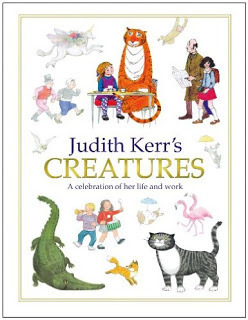 HarperCollins have published this beautiful book as a tribute to Judith Kerr, who was ninety this month. It is an autobiography of a life shaped by art, family and a deep love of cats. But don't think that means Judith Kerr is a dear little old lady with a feline obsession. There is a razor-sharp intelligence at work in her clear-sighted analysis of the events of her life.
HarperCollins have published this beautiful book as a tribute to Judith Kerr, who was ninety this month. It is an autobiography of a life shaped by art, family and a deep love of cats. But don't think that means Judith Kerr is a dear little old lady with a feline obsession. There is a razor-sharp intelligence at work in her clear-sighted analysis of the events of her life.I was particularly touched by the way she wanted to put the record straight about the portrayal of her father in her novels, now known by the overall title of Out of the Hitler Time. It was a trilogy of fictionalised autobiography, whose first volume was called When Hitler Stole Pink Rabbit, now re-issued by HarperCollins in an anniversary edition.
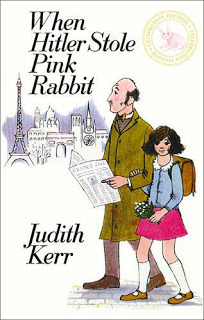
But my favourite was always the second book, originally entitled The Other Way Round, in which young Anna (Judith Kerr's first forename in Anna) experiences that most poignant of aspects of growing up, when the child becomes protective and caring of the parent. (It appears that she doesn't like the original title - which I think is perfect - and the book is now called Bombs on Aunt Dainty, which seems to me inappropriately Mitfordesque).
Anyway, in Creatures, Judith Kerr revisits what her father was doing during the war, after he had sensibly removed his whole family from Germany in the '30s. "I did not know that all this time my father, too, was battling to earn money for his family because he never spoke about it. I still did not know it when I wrote Bombs on Aunt Dainty in 1973, and I described my mother making all the efforts while my father, while writing beautiful words, remained fairly inactive. I now know this is totally wrong."
It is rather wonderful that she has had this opportunity to revise her family history and I'm sure if there is an afterlife Alfred Kerr is glowing. It's also another sign of what we learn as adults: that what we always believed to be true might have been quite different.
But this is not at all a sombre book, nor even an elegaic one, in spite of the many losses a ninety-year-old will inevitably have endured. Parents, a brother, her husband and many, many cats. What stands out to me is that she has been tremendously loved. Of her fifty-plus years of marriage to Tom Kneale (the television writer Nigel Kneale), she writes, "we had never run out of things to talk about." What better could be said of a long and happy union?
They had two children, the artist Tacy Kneale, who specialises in insect paintings, and the novelist, Matthew Kneale, whose The English Passengers won the Whitbread for 2000. (He now lives in Rome, which he decided he would do at age ten).
Writing and drawing - that's what the Kneale/Kerr household was all about: "What can you say about a life that consists of two people sitting in adjoining rooms for forty-odd years making marks on bits of paper?" Quite a lot as it turns out!
Of course, what we all know about Judith Kerr and what makes her an "NT" (which she would hate to be called as much as Judi Dench does, I'm sure) are her wonderful picture books.
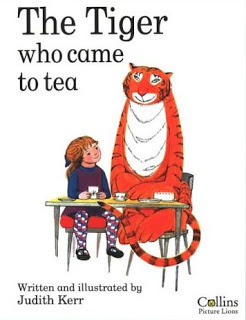
The Tiger who came to Tea - and stayed forever in the hearts of generations of children - began, like so many successful tales, as a story to tell her children. It was only when they were both at school all day that Judith Kerr had enough time to turn it into a picture book. She took her idea and pictures to her husband's agent and there was a meeting at Collins Children's Blooks. The rest is history.
In this gorgeous book, The Tiger who came to Tea is reproduced in full. How many parents since 1968 have been grateful to those 32 pages? Our three girls were brought up on them ten years and more later and we have given this book to many new parents.
It is amusing to hear that the Collins editors wanted the spread in which the tiger drinks all the water from the tap removed. "Rather unrealistic," they said. But Judith Kerr stuck to her guns: "I said the bit about the water in the tap was the part my children liked best." Good for her!
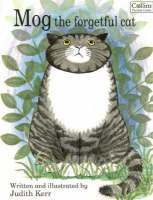
Mog the Forgetful Cat soon followed and ended up with eleven picture book titles plus board books, including the heartbreaking Goodbye, Mog, when the beloved cat was at last allowed to die, after thirty-two years. This animal entered the nation's unconscious, becoming the template for all rather eccentric felines. She was based on a real Mog in the family but gradually acquired the characteristic of a long line of pet cats.
There were other picture books too - about an angel, a Goose, and lots of Grannies (based on the cohort of elderly widowed women Judith Kerr found herself a part of in 2000).
I think Judith Kerr really underestimates herself as a writer and I hope it's not because she was married to one and the mother to another. Picture book texts are extremely hard to write: they are like poems, where every word has to justify its place and be absolutely right. So much of her writing has entered our family language and I'm sure that of many families.
This is a book for adults. You can read it in an hour and a half, as I did, and then spend many more hours poring over the pictures. Not just finished artwork but sketches, early paintings, the unexpected and lovely textile designs from the '50s, old family photographs. It is a fitting and beautifully-produced celebration of a much-loved writer and artist.
Thank you, HarperCollins, and thank you so much, Judith Kerr for enhancing childhood - and parenthood - for so many people.

Published on June 28, 2013 04:11
June 6, 2013
Veuve Cliquot on the Grand Canal
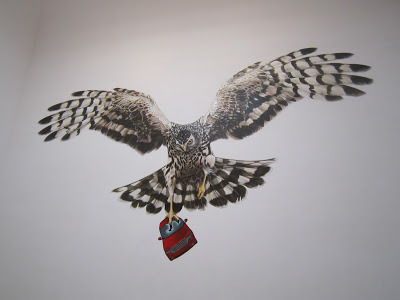 Jeremy Deller at the British Pavilion
Jeremy Deller at the British PavilionWe were not in Venice FOR the Biennale, you understand. We just happened to be there the weekend it opened to the public. The really grand events are the parties before the public opening but I think I would have hated those. Still, since we were there and it was on and we probably will never experience that conjunction again, we went.
The Exhibition takes place in two ways. There are the main shows in two places: The Arsenale and the Giardini and you buy a joint ticket which gives you one entrance to each. At the Arsenale there is one enormous space divided into rooms, at the Giardini, there are separate Pavilions for each nation, the picture above being by Jeremy Deller, who curated the British one.
But the other way is much more serendipitous and sometimes better. Individual artists and smaller nations take over a palazzo or other space and you go in for free.
We paid our money and went through every room in the Arsenale. (I thought of Molly Bloom - "nice name [it] has!"). We saw wooden tables which has five legs all on one side or one zigzag one. We saw a monstrous ?Flight Attendant and many. many videos.

We walked round till our legs ached. Alarming and disturbing but very powerful was a vast room of skeletons made in grey plastic. Actually, not all skeletons; some had ribbons of flesh still attached. They were Venetians by Pawel Althamer.
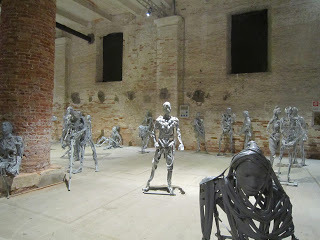
And a giant structure of what seemed to be stone but was in fact 3D printed and then treated with stone-dust, called Belinda. This was by Roberto Cuoghi

In the Giardini, after a roomful of pages from Jung's Red Book, we encountered the first of Tino Sehgal's performers. At first I thought a young woman was having an epileptic fit and was relieved to find she could control her movements while the young man writhing on the floor beside her beatboxed. For this untitled piece Sehgal won the Golden Lion for best Artist at the Biennale.
I was quite glad Roberto Cuoghi got a special mention.
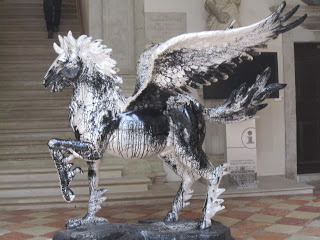
In the Palazzo Pisani, outside the main exhibition, the wings were on a horse by Simon Ma, the second most famous Chinese artist featured in the Biennale. His exhibition, called Ink - Brush - Heart, featured forms based on water drops.

There was something quite haunting about Ma's work, which included semi-abstract peacock paintings as well.
There was a funeral in Madonna dell'Orto, so we saw another free exhibition in the building next door : Jorge Pombo's Variazioni di Tintoretto. This Barcelona artist had taken an original painting by Tintoretto, The Miracle of Saint Mark, currently housed in the Accademia in Venice, and systematically deconstructed it in several huge canvases, showing the scene more and more blurred and broken down.
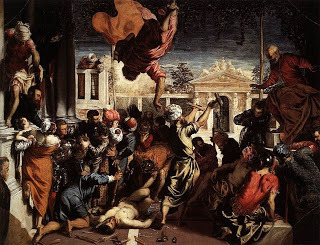 Tintoretto's original
Tintoretto's original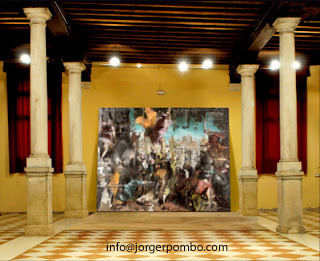 One of Pombo's Variations
One of Pombo's VariationsThis one is still quite recognisable. I don't know how great the Variations cycle really is but it was painted by someone with considerable talent and a clear idea of what he wanted to do.
In Madonna dell'Orto's Clositer was the best exhibition of the lot: Emily Young's massive head sculptures, in an exhibition called We Are Stone's Children. In materials ranging from Dolomitic Limestone to Lapis Lazuli, partial heads, profiles or half-views emerge from the rock like Michelangelo's Slaves in Florence's Accademia.
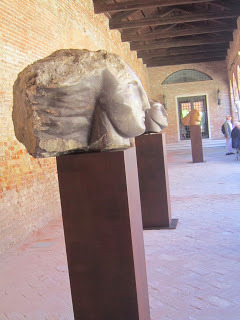
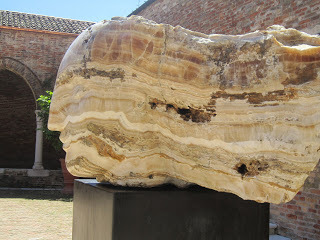
If I'd had a spare hundred and fifty grand, one of these would have ended up in my garden. You can catch the exhibition in London 6th-26th September at the Fine Art Society Gallery.
We missed the smart parties but were present at one of our own, with American art critic Patricia Fortini Brown, Shakespeare and Children's Literature scholar, Laura Tosi plus a writer, poet, musician, dancer and sculptor (the last four were all one person). Veuve Cliquot was consumed and Art and Literature discussed while overlooking the Grand Canal. That was quite smart enough for me.
What does the Biennale teach us about books, if anything? Here are two pictures:
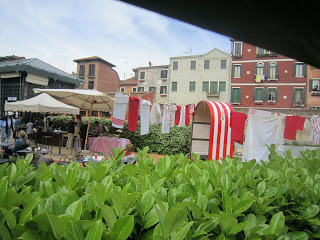
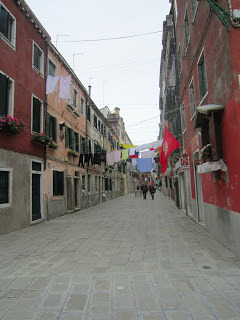
One is "Art", the other just washing. I'm sure you can work out which is which. There is too much of the former and not enough of the latter in much fashionable literature, including children's literature. It's not so much a question of the Emperor's new clothes not being there; too often there isn't even any Emperor. Just a Press Release and a puff from a big name.
I would award my Golden Lion to Emily Young.
Published on June 06, 2013 09:20
May 26, 2013
Woolly bullies and Book snatchers
Two great picture books from Scholastic.

You don't very many books about mammoths. Though they featured in Julia Donaldson and Emily Gravett's Cave Baby three years ago. I was immediately put in mind of a friend who had a fierce grey cat called Woolly Bully.
But the grey mammoths in this book are kind, A mother and father and two older brothers, who welcome the new baby and call her Woolly. Only she isn't. She is a naked pink baby mammoth and for most of the book her family are finding ways to dress her in warm coverings so that she can out and make friends.
The most successful outfit is a onesie - complete with cap - knitted from goat wool. But poor Woolly feels too hot, on the coldest day of winter. And when the woollen onesie unravels she is revealed in all the glory of pink woolliness.
It's a lovely warm (!) book, written and illustrated by Sam Childs (who used to be Susie jenkin-Pearce, until she developed a new style with the Little Zeb books). I wish it hadn't been a girl mammoth though - that association of girls with pink is too deeply entrenched elsewhere.
Another book from Alison Green's imprint at Scolastic is The Snatchabook:
 This might not be the final cover image
This might not be the final cover image
by Helen and Thomas Docherty, a husband and wife team.
"In every house,
In every bed,
A bedtime book
was being read."
If only! This is an idyllic woodland world, where all creatures take seriously their bedtime parental responsibilities. But something, someone, has been stealing all the books. Eliza Brown, a rabbit who lives in a tree, tracks down the thief.
And instead of being punished, the deprived little Snatchabook is allowed to hear a bedtime story in a different home every night.
This one's not out yet but it's going to be a hit. I saw them both in Bologna.

You don't very many books about mammoths. Though they featured in Julia Donaldson and Emily Gravett's Cave Baby three years ago. I was immediately put in mind of a friend who had a fierce grey cat called Woolly Bully.
But the grey mammoths in this book are kind, A mother and father and two older brothers, who welcome the new baby and call her Woolly. Only she isn't. She is a naked pink baby mammoth and for most of the book her family are finding ways to dress her in warm coverings so that she can out and make friends.
The most successful outfit is a onesie - complete with cap - knitted from goat wool. But poor Woolly feels too hot, on the coldest day of winter. And when the woollen onesie unravels she is revealed in all the glory of pink woolliness.
It's a lovely warm (!) book, written and illustrated by Sam Childs (who used to be Susie jenkin-Pearce, until she developed a new style with the Little Zeb books). I wish it hadn't been a girl mammoth though - that association of girls with pink is too deeply entrenched elsewhere.
Another book from Alison Green's imprint at Scolastic is The Snatchabook:
 This might not be the final cover image
This might not be the final cover imageby Helen and Thomas Docherty, a husband and wife team.
"In every house,
In every bed,
A bedtime book
was being read."
If only! This is an idyllic woodland world, where all creatures take seriously their bedtime parental responsibilities. But something, someone, has been stealing all the books. Eliza Brown, a rabbit who lives in a tree, tracks down the thief.
And instead of being punished, the deprived little Snatchabook is allowed to hear a bedtime story in a different home every night.
This one's not out yet but it's going to be a hit. I saw them both in Bologna.
Published on May 26, 2013 10:55
May 13, 2013
My new website
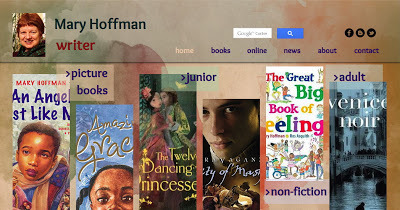
My new website has been designed for me by Anne Rooney. It is my fourth in about thirteen years. And the great thing about this one, made using Wix, is that I can update it myself.
Well, when I say "I can," it has been a bit of a learning curve and I'm not at the crest of that wave yet. But it is really learnable and will get easier every time I do it. Anne gave me good instructions and then held my hand through the first update (well, not literally: I needed both hands to do it).
One of the problems is that I have written an awful lot of books and an awful lot of kinds of book. Not really "awful" - at least not most of them. And not as many as Anne.
But I think it's a lot easier to navigate round the new site. Even though it has made no difference to how well I navigate round my working life. You can't have everything.
Published on May 13, 2013 10:11
May 1, 2013
Where have all the Canalettos gone?
We haven't had a guest post on Book Maven for a while, but today we welcome a special one. It is publication day for Michelle Lovric's The Fate in the Box, her fourth children's book for Orion. This, like all Michelle's other titles, for children or adults, take inspiration from Venice as a setting. In her guest post for Book Maven, starting off her Blog Tour, Michelle talks about Venice then and now and what has happened to all the Canaletto paintings for which the city was the subject.
 Rio dei Mendicanti
Rio dei Mendicanti
<!-- /* Font Definitions */ @font-face {font-family:"Cambria Math"; panose-1:2 4 5 3 5 4 6 3 2 4; mso-font-charset:0; mso-generic-font-family:auto; mso-font-pitch:variable; mso-font-signature:-536870145 1107305727 0 0 415 0;} /* Style Definitions */ p.MsoNormal, li.MsoNormal, div.MsoNormal {mso-style-unhide:no; mso-style-qformat:yes; mso-style-parent:""; margin:0cm; margin-bottom:.0001pt; mso-pagination:widow-orphan; font-size:12.0pt; font-family:"Times New Roman"; mso-fareast-font-family:"Times New Roman"; mso-fareast-language:EN-GB;} a:link, span.MsoHyperlink {mso-style-unhide:no; color:blue; text-decoration:underline; text-underline:single;} a:visited, span.MsoHyperlinkFollowed {mso-style-noshow:yes; mso-style-priority:99; color:purple; mso-themecolor:followedhyperlink; text-decoration:underline; text-underline:single;} .MsoChpDefault {mso-style-type:export-only; mso-default-props:yes; font-size:10.0pt; mso-ansi-font-size:10.0pt; mso-bidi-font-size:10.0pt;} @page WordSection1 {size:595.3pt 841.9pt; margin:72.0pt 89.85pt 72.0pt 89.85pt; mso-header-margin:35.45pt; mso-footer-margin:35.45pt; mso-paper-source:0;} div.WordSection1 {page:WordSection1;} -</style>Antonio Canaletto’s painting of this area shows it as it was in 1724 – a poor, crowded place with pennants of dyed cloth drying on racks on the roofs. ‘Mendicanti’ means ‘beggars’ in Italian. One of the city’s poorhouses was on this canal, and it doubled as a famous musical academy for young orphan girls. It was such during the late eighteenth century. the time that my new children’s novel, The Fate in the Box, is set.<br /><br />My young heroine, Amneris, wakes every dawn to the lovely sound of the singing orphans’ hymns floating across the water to her home in the Calle Berlendis where she and her family eke out a humble living embroidering silk and fashioning parasols for the noblemen and women of Venice.<br /><br /><div class="separator" style="clear: both; text-align: center;"><a href="http://2.bp.blogspot.com/-KeeOoqGu4Fs..." imageanchor="1" style="margin-left: 1em; margin-right: 1em;"><img border="0" height="240" src="http://2.bp.blogspot.com/-KeeOoqGu4Fs..." width="320" /></a></div><br />Here is my photograph of the same scene, taken last summer. The pennants are gone but the Rio dei Mendicanti is still remarkably similar, at least in terms of the external architectural elevations. The changes are all internal. The Mendicanti has long since been taken over by the Ospedale Civile, possibly the most beautiful place to be sick in the world. It is possible to wander around the ground floor, from tree-filled cloister to tree-filled cloister, listening to the songs of birds that have replaced the musical orphans. The church of San Lazzaro is ‘incastrata’ inside, and it is always worth pushing at its formidable door in case it’s unlocked. <br /><br />Another secret of the hospital is the green space which, I’m fairly sure, once enclosed the stables where Venetian noblemen kept their horses. The surrounding accommodation looks more suitable for horses than for nuns, and the well might well have served the animals, given its great circumference. Now it is occupied by a colony of well loved cats. <br /><br />So – everything stays the same in Venice, and nothing stays the same. But something that has changed quite grievously is the number of paintings by Canaletto that can still be seen in his native city. Extraordinarily enough, given the artist’s vast output, only two remain in the city. The rest are to be found in collections around the world, with many in England. <br /><br />There is an English reason for this too. Canaletto’s agent, for a considerable period, was Joseph Smith, who served as the British consul in Venice between 1744 and 1760. Even before his official tour of duty, Smith, a friend of Casanova’s, brokered the sale of paintings to British Grand Tourists. He organized Canaletto’s sojourn in London from 1746 – 55. Smith also acquired a large number of Canaletto’s works himself, eventually selling his entire collection to George III. They can still be seen in the Royal Collection at Windsor. Four others are at Castle Howard; there is a fine group in the Wallace Collection and another in the National Gallery. <br /><br />Although his reputation declined after his London sojourn, the market in Canaletto’s works never ceased to thrive. His paintings have ended up in the Hermitage, the Louvre, the Thyssen-Bornemisza Museum in Madrid, and in museums in New York, Washington, Harvard, Indianapolis, Yale, Houston, Fort Worth, Melbourne, Cardiff and Ottawa. <br /><br />Apart from the Rio dei Mendicanti, the only other painting that has remained in the artist’s birthplace is Venice, Grand Canal from Palazzo Balbi toward the Rialto (1720–1723), also at Ca’ Rezzonico. <br /><br />Am I the only one who finds it rather sad that Canaletto should be so poor represented in the city whose image he did more than any other painter to create and refine for the Grand Tourists of Europe? Canaletto created a Venice full of energy and joy. His canals are crowded with regattas, working boats and real Venetians. Later artists – and writers – have often preferred to show the city in a state of picturesque decline, projecting misery upon her to serve their own ‘poetical’ purposes. But I love Canaletto, because he showed the city at work and play, self-conscious of her beauty and outrageously nonchalant about her wonders too. This is the Venice I prefer to write about, and plan to keep celebrating in my books as long as I possibly can.<br /><br /><div class="separator" style="clear: both; text-align: center;"><a href="http://2.bp.blogspot.com/-6mRxjWx4O3A..." imageanchor="1" style="margin-left: 1em; margin-right: 1em;"><img border="0" height="320" src="http://2.bp.blogspot.com/-6mRxjWx4O3A..." width="242" /></a></div><br /><br />Other stops on Michelle's Blog Tour include <a href="http://the-history-girls.blogspot.com... History Girls</a>, <a href="http://bookwitch.wordpress.com/"..., <a href="http://awfullybigblogadventure.blogsp..., <a href="http://www.thecourtauldian.co.uk/&quo... Courtauldian </a>and <a href="http://www.englishwritersinitaly.com/... in Italy.</a><br /><br /><a href="http://www.amazon.co.uk/The-Fate-Box-... Fate in the Box</a> is published May 2 by Orion Children’s Book <br /><br />Michelle Lovric’s <a href="http://www.michellelovric.com/childre... <br /><br />New website pages for the book are <a href="http://www.michellelovric.com/childre... /><div class="MsoNormal"><br /></div>
 Rio dei Mendicanti
Rio dei Mendicanti<!-- /* Font Definitions */ @font-face {font-family:"Cambria Math"; panose-1:2 4 5 3 5 4 6 3 2 4; mso-font-charset:0; mso-generic-font-family:auto; mso-font-pitch:variable; mso-font-signature:-536870145 1107305727 0 0 415 0;} /* Style Definitions */ p.MsoNormal, li.MsoNormal, div.MsoNormal {mso-style-unhide:no; mso-style-qformat:yes; mso-style-parent:""; margin:0cm; margin-bottom:.0001pt; mso-pagination:widow-orphan; font-size:12.0pt; font-family:"Times New Roman"; mso-fareast-font-family:"Times New Roman"; mso-fareast-language:EN-GB;} a:link, span.MsoHyperlink {mso-style-unhide:no; color:blue; text-decoration:underline; text-underline:single;} a:visited, span.MsoHyperlinkFollowed {mso-style-noshow:yes; mso-style-priority:99; color:purple; mso-themecolor:followedhyperlink; text-decoration:underline; text-underline:single;} .MsoChpDefault {mso-style-type:export-only; mso-default-props:yes; font-size:10.0pt; mso-ansi-font-size:10.0pt; mso-bidi-font-size:10.0pt;} @page WordSection1 {size:595.3pt 841.9pt; margin:72.0pt 89.85pt 72.0pt 89.85pt; mso-header-margin:35.45pt; mso-footer-margin:35.45pt; mso-paper-source:0;} div.WordSection1 {page:WordSection1;} -</style>Antonio Canaletto’s painting of this area shows it as it was in 1724 – a poor, crowded place with pennants of dyed cloth drying on racks on the roofs. ‘Mendicanti’ means ‘beggars’ in Italian. One of the city’s poorhouses was on this canal, and it doubled as a famous musical academy for young orphan girls. It was such during the late eighteenth century. the time that my new children’s novel, The Fate in the Box, is set.<br /><br />My young heroine, Amneris, wakes every dawn to the lovely sound of the singing orphans’ hymns floating across the water to her home in the Calle Berlendis where she and her family eke out a humble living embroidering silk and fashioning parasols for the noblemen and women of Venice.<br /><br /><div class="separator" style="clear: both; text-align: center;"><a href="http://2.bp.blogspot.com/-KeeOoqGu4Fs..." imageanchor="1" style="margin-left: 1em; margin-right: 1em;"><img border="0" height="240" src="http://2.bp.blogspot.com/-KeeOoqGu4Fs..." width="320" /></a></div><br />Here is my photograph of the same scene, taken last summer. The pennants are gone but the Rio dei Mendicanti is still remarkably similar, at least in terms of the external architectural elevations. The changes are all internal. The Mendicanti has long since been taken over by the Ospedale Civile, possibly the most beautiful place to be sick in the world. It is possible to wander around the ground floor, from tree-filled cloister to tree-filled cloister, listening to the songs of birds that have replaced the musical orphans. The church of San Lazzaro is ‘incastrata’ inside, and it is always worth pushing at its formidable door in case it’s unlocked. <br /><br />Another secret of the hospital is the green space which, I’m fairly sure, once enclosed the stables where Venetian noblemen kept their horses. The surrounding accommodation looks more suitable for horses than for nuns, and the well might well have served the animals, given its great circumference. Now it is occupied by a colony of well loved cats. <br /><br />So – everything stays the same in Venice, and nothing stays the same. But something that has changed quite grievously is the number of paintings by Canaletto that can still be seen in his native city. Extraordinarily enough, given the artist’s vast output, only two remain in the city. The rest are to be found in collections around the world, with many in England. <br /><br />There is an English reason for this too. Canaletto’s agent, for a considerable period, was Joseph Smith, who served as the British consul in Venice between 1744 and 1760. Even before his official tour of duty, Smith, a friend of Casanova’s, brokered the sale of paintings to British Grand Tourists. He organized Canaletto’s sojourn in London from 1746 – 55. Smith also acquired a large number of Canaletto’s works himself, eventually selling his entire collection to George III. They can still be seen in the Royal Collection at Windsor. Four others are at Castle Howard; there is a fine group in the Wallace Collection and another in the National Gallery. <br /><br />Although his reputation declined after his London sojourn, the market in Canaletto’s works never ceased to thrive. His paintings have ended up in the Hermitage, the Louvre, the Thyssen-Bornemisza Museum in Madrid, and in museums in New York, Washington, Harvard, Indianapolis, Yale, Houston, Fort Worth, Melbourne, Cardiff and Ottawa. <br /><br />Apart from the Rio dei Mendicanti, the only other painting that has remained in the artist’s birthplace is Venice, Grand Canal from Palazzo Balbi toward the Rialto (1720–1723), also at Ca’ Rezzonico. <br /><br />Am I the only one who finds it rather sad that Canaletto should be so poor represented in the city whose image he did more than any other painter to create and refine for the Grand Tourists of Europe? Canaletto created a Venice full of energy and joy. His canals are crowded with regattas, working boats and real Venetians. Later artists – and writers – have often preferred to show the city in a state of picturesque decline, projecting misery upon her to serve their own ‘poetical’ purposes. But I love Canaletto, because he showed the city at work and play, self-conscious of her beauty and outrageously nonchalant about her wonders too. This is the Venice I prefer to write about, and plan to keep celebrating in my books as long as I possibly can.<br /><br /><div class="separator" style="clear: both; text-align: center;"><a href="http://2.bp.blogspot.com/-6mRxjWx4O3A..." imageanchor="1" style="margin-left: 1em; margin-right: 1em;"><img border="0" height="320" src="http://2.bp.blogspot.com/-6mRxjWx4O3A..." width="242" /></a></div><br /><br />Other stops on Michelle's Blog Tour include <a href="http://the-history-girls.blogspot.com... History Girls</a>, <a href="http://bookwitch.wordpress.com/"..., <a href="http://awfullybigblogadventure.blogsp..., <a href="http://www.thecourtauldian.co.uk/&quo... Courtauldian </a>and <a href="http://www.englishwritersinitaly.com/... in Italy.</a><br /><br /><a href="http://www.amazon.co.uk/The-Fate-Box-... Fate in the Box</a> is published May 2 by Orion Children’s Book <br /><br />Michelle Lovric’s <a href="http://www.michellelovric.com/childre... <br /><br />New website pages for the book are <a href="http://www.michellelovric.com/childre... /><div class="MsoNormal"><br /></div>
Published on May 01, 2013 16:01
April 19, 2013
Lucky thirteen at LBF?
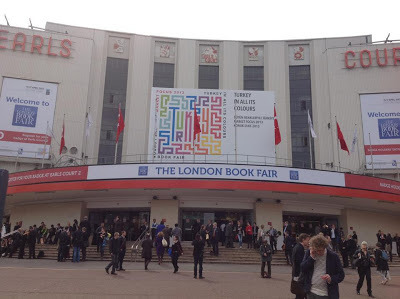
There were nearly three weeks between Bologna and the London Book Fair but in the meantime I had another trip to Italy, teaching American women writers on the Writers' Renaissance course. The organiser for that, Julie Hedlund, took the above photo of the LBF entrance, where I managed to meet her at the end of a bewildering day. I wonder how many people, like Julie and myself, have had a really hectic literary spring?
Last year, three of us went to LBF together: myself, Lucy Coats and Anne Rooney. This year, with the same companions, I had fewer appointments and more time for talks and seminars (must get my act together sooner next year!). But I found almost all the sessions I went to deeply disappointing - not enough preparation or thinking by the participants and too many people not delivering what the label said on the tin.
There was nothing I went to as good as Nicolette Jones' interview with Patrick Ness last year but I might just have been unlucky. Not sure why I wrote "kill me now" in my notes but that was in one of the better sessions.
As always, it's the serendipitous encounters that make a Fair worth attending by an author.

This was our "office" last year, a table in the Illustrators' Bar in the Children's Zone. And indeed we did start with coffee there this year but soon found a quieter area near the seminar rooms upstairs. The only trouble was at times many other people had found it too but I did have one very good talk with an academic I had arranged to meet at LBF.
People ask "why should a writer go to a Rights Fair?" and mutter darkly about cattle and markets but I think you need to know what you want to get from your visit. Here's my list:
• a chance to meet people who will be in London for the Fair (convenient to fit appointments all in one time and space, especially if you no longer live in the capital)
• a further chance to catch up with your publishers when the whole team is likely to be there - editorial, sales, rights, publicity
• an extra meeting with your agent
• serendipitous encounters in the aisles
• random parties and launches which are fun and might lead to useful new contacts
• a sight of forthcoming books and possible identification of trends
• possible insights from sessions attended (sparse this year)
You come back from the Fair with catalogues, flyers, a sheaf of business cards and, if you're lucky, a headful of ideas. But you have to go with an open mind and be determined not to be overwhelmed by thoughts of insignificance in the face of giant posters of authors' faces and book jackets of bestsellers. You have to be more like Zaphod Beeblebrox faced with the fairy cake in the Total Perspective Vortex and less like Fanny Price arriving at Mansfield Park.
Chutzpah is the essential ingredient that will get you into parties, make you memorable to publishers and promote your books or even your "brand" if you are lucky enough to have one.

These charming young people were advertising Superego by Julia Wurz, wife of Formula 1 racing driver Alex Wurz, who had self-published her novel. I haven't read it but I admired the promotion.
Self-publishing was one of the dominant themes of the Fair, according to the Bookseller, who bring out a daily edition on all three days. The Alliance of Independent Authors was celebrating its first birthday and if you want to know what they do, you'll get a better idea from Orna Ross's article in Publishing Talk than from the session at the Fair.
Self-publishing and the setting up of small independent publishing houses, like Peirene Press, were everywhere. You have to find a gap in the market, a niche that no-one else is interested in filling.
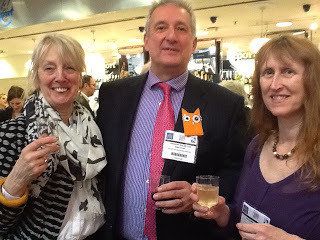 Su Swallow, Andrew Macmillan and Anne Rooney
Su Swallow, Andrew Macmillan and Anne RooneyThis is the launch of a brand-new imprint, ReadZone, so new they weren't in the Fair catalogue and didn't have a stand. This was their office this year:

But I expect they'll have a much bigger presence next year! ReadZone launched on the first day of the Fair, offering titles for 5-25 year-olds. They bought a lot of books from Evans when it ceased trading and have an attractive catalogue full of everything from a tie-in with the film Untouchable to graphic novel versions of Dickens and Shakespeare. I predict we'll be seeing a lot of their stylish orange owl in future.
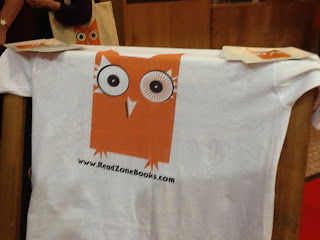
Social Networking continues to be a big issue, though there are few signs of its being well-used by writers. We can't all be John Green - alas - but it should surely be easy enough to help writers learn the difference bewtween a website and a blog, Twitter and Facebook, Tumblr and Pinterest. The difference between a personal Facebook account and an Author Page.
One of the best sessions I attended was on Blogging. Nina Douglas, Publicity Manager of Orion and Kat McKenna, Children's Marketing and Publicity Executive for Simon & Schuster interviewed Casey Devoren of Dark Readers and Jo Stapley of Once Upon a Bookcase. They were both hooked on YA books and series, Jo especially on Urban Fantasy. Actually, from the way they spoke, it's probably New Adult (NA) that really floats their boats and they have extended their reviewing to cover adult titles too.
This session was full of useful references and links and even advice for would-be bloggers. Watch this space to see what I have learned!
New Adult was another theme of the Fair but does it really exist? Not many people had a satisfactory definition for it. Brenda Gardner of Piccadilly Press thought it a convenient term. Victoria Barnsley, HarperCollins m.d., had suggested to Radio 4's You and Yours programme, which broadcast live from the Fair on the first day that it was a "publishers' construct" that she didn't really believe in. Cat Banks, however, who is the Children's category buyer for Bertrams, thought NA came "between where young adult ends and contemporary women’s romance starts”.
One very experienced scout, who shall be nameless, gave me the definition for NA = "badly written" and what I heard of the genre, if it is one, at the Fair gave some credibility to that. So far, it seems to be YA + sex. The most interesting thing I heard about it is that most titles sell 70% digitally and 30% print.
London Book Fair is not as easy to understand as Bologna; the signage is poor and people waste a lot of time getting lost - though this can also lead to those serendipitous encounters which are so important. Maybe it falls somewhere between Bologna (children's only) and Frankfurt (where I have never been). The Rights Centre on the first floor is certainly more Orwellian than the Agents' Centre in Bologna; maybe that's appropriate for the rash of Dystopian novels that keep coming.

But they do have a branch of The Ivy up there, where you can get seafood and champagne. I dread to think what that might cost when a small bottle of water is £2.20 and a sandwich and drink can set you back £8. On one of my visits upstairs, I limited myself to a cup of tea, courtesy of a friend and literary agent in the US. I am, please note, a cheap date.
Still, I'll be back next year. I think I have become a Book Fair addict. Is there an App for that?

Published on April 19, 2013 04:32
April 9, 2013
Bologna 2013 Day Three

This was a special Bologna - the 50th anniversary of the Children's Books Rights Fair that had started back in 1964 with about twenty publishers round a table in a palazzo in the town centre. This year there were 1,200 exhibitors from more than 70 countries. Since 1967, there has also been an Illustrators' Exhibition and this year's Special Guest was Sweden.
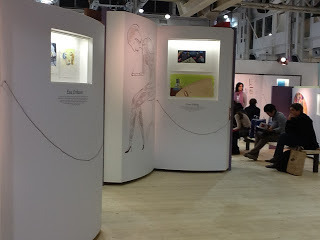
My first official port of call on Day Three was Scholastic but I had time to nip in quickly and say hello to Kate Wilson on the Nosy Crow stand. They are now publishing in over twenty languages and are up to fifty titles a year - which Kate thinks is a good limit. Lucy Coats has a very disgusting pirate picture book coming out with them next year, called Captain Beastlie's Birthday, illustrated by Chris Mould, who is currently on the shortlist for the Kate Greenaway Medal.
Scholastic had some nice picture books too - The Snatchabook by Helen and Thomas Docherty and Woolly by Sam Childs, about a baby mammoth born naked and chilly. M.D. Hilary Murray Hill was very upbeat about the future of books, not giving any credence to the idea that YA was on the wane.
"The quality of the writing comes first," she said, about any book that comes over her desk, whether YA or whatever age group and in whatever genre.
It was a bit disorientating to visit Alyx Price on the Macmillan stand! She had been their head of Publicity eight years ago, when she went to Scholastic at the same time as Marion Lloyd, Kate Wilson and Alison Green. Now she's back at Macmillan doing maternity leave cover and was telling me about their new books only weeks into the new job.
The gold standard picture book author and current Children's Laureate Julia Donaldson has a new title, Sugarlump and the Unicorn coming out next year, illustrated by Lydia Monks. And the new young talent Rebecca Cobb, who had just won the Waterstone's Prize, has a new book called Aunt Amelia, which was attracting attention. It was a bit retro, nicely reminiscent of the early days of Joihn Burningham and Brian Wildsmith.
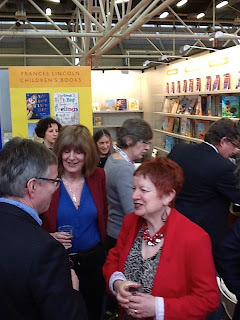
I promised to tell you the story about the Faroe Islands. Above you can see me and Ros talking to our Faroese Publisher, Niels Jakup Thomsen at the launch party. Janetta mentioned it in her speech but this what happened: The Faroese government had a debate coming up on Gay marriage, so Niels thought he would give every MP a copy of The Great Book Book of Families, which happens to contain one line and one illustration that takes it for granted that some families have two mums or two dads.
There are only 33 MPs in the Faroese Government but it was an imaginative plan. A television company filmed one of the three Christian Party MPs opening the book, with the predictable harumphing. So then Niels himself was on the TV defending the book!
So, it was Day Three and we were going home in the afternoon. I just had time for three more appointments. First up was Stephanie Thwaites, the Children's Agent at Curtis Brown. She made an interesting point that it's harder to sell books with male protagonists than female. (My two current projects both have male leads!) Her client Martin Bedford, who had done so well at Walker with his book Flip, had switched to a female lead for his new title, Neverending.
Stephanie was not the only person to suggest there is a trend developing towards contemporary romance.
I met three students from Oxford Brookes' Publishing MA, who were enterprisingly visiting the Fair and seemed very on the ball with all the latest developments. And then it was time for a final lunch in one of the restaurants at the Fair - this time with Venetian Professor Laura Tosi, who has written a book in Italian about English children's books, and critic Peter Hunt, a now retired academic, who wrote many articles for the children's literature journal Signal.
And back to the UK, after another 40-minute wait on the runway for the same reason as on the way out and a baggage-reclaim delay caused by a machine getting stuck in the doorway! I crawled into bed at midnight after three full days and three short nights, knowing I must sort through pages of notes, handfuls of business cards and a suitcase full of Rights catalogues.
Not everything was the same as in years past - including the weather - but on the whole another good Fair and a sense that children's books were holding up well in the recession.
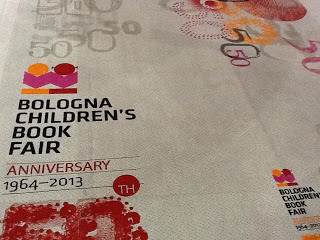
Published on April 09, 2013 16:01
April 5, 2013
Bologna 2013 Day Two
 Philip Reeve, Sarah McIntyre and the Seawigs at OUP's stand
Philip Reeve, Sarah McIntyre and the Seawigs at OUP's standMy last post began with a picture of Sarah McIntyre and this one opens with the lady herself in all her pantomime glory! She and Philip Reeve attracted a lot of attention in the costumes they donned to promote Oliver and the Seawigs, a quartet of books initially inspired but soon elaborated from the CWIG group of the Society of Authors (which actually stands for Children's Writers and Illustrators Group). A happy conjunction all round for OUP.
And a more cheerful sight than Lucy and me gnashing our teeth and pulling our hair over the non-functionality of WiFi in our hotel and at the Fair. That is not pretty.
But there was not long to lament it as my first hour was at the big Bonnier stand, first with Hot Key and then with Templar.
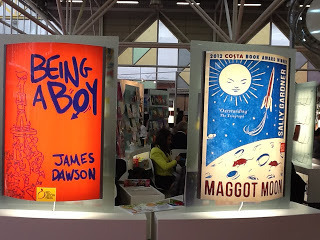
Hot Key go from strength to strength. They publishing nine titles last year, one of which - Sally Gardner's Maggot Moon - won the children's Costa Award and is shortlisted for the Carnegie Medal. In 2013 there will be fifty! This is Maggot Moon's adult cover, which I much prefer, with its flavour of Stalinist propaganda posters.
One of the things much talked about as a new trend in YA was crime and thrillers and Hot Key are publishing next year the sequel to Anne Cassidy's Looking for JJ, which will be called Finding Jennifer Jones. It will be ten years, coincidentally, since Anne herself was shortlisted for the Costa, when it was still called the Whitbread, with Looking for JJ (and won the Booktrust Teenage Book Prize for it).
If YA Crime really is making a comeback., Anne Cassidy will clean up, since she has always written in that genre and has a series out at present with Bloomsbury, called The Murder Notebooks. Hot Key publish a large range of genres, from historical fiction by Lydia Syson to Matt Whyman's The Savages, about a family of cannibals.
Templar had one of the most attractive picture books at the Fair, Winter's Child by Graham Baker-Smith.
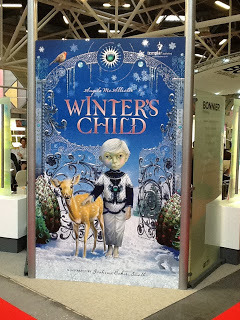
They were celebrating ten years of their -Ology titles with Dinosaurology, the twelfth in the series, which has sold 16 million copies in 35 languages. Another exciting forthcoming title from them is Cate Cain's The Jade Boy, a début novel in September about what really started the Great Fire of London.
The rest of the day went on my own work, first meeting with Liber magazine, an Itlain journal for children's books, for which I write the occasional article and then the Italian publishers Lo Stampatello, who publish my Great Big Books from Frances Lincoln.
 Riccardo Pontegobbi of Liber and Maria Silvia Fuengo of Lo Stampatello
Riccardo Pontegobbi of Liber and Maria Silvia Fuengo of Lo StampatelloI am writing a very hard book for Frances Lincoln and Lo Stampatello! More of that next year perhaps. But in Bologna we were spending part of the second day launching The Great Big Book of Feelings, written by me, illustrated by Ros Asquith, edited and published by Janetta Otter-Barry and Art Directed by Judith Escreet. We really are an "awesome foursome" when working together.
First there was a splendid party at Frances Lincoln's new stand, as part of Quarto.
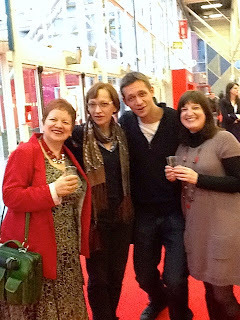 Me with my Slovenian publishers and Rights Manager Caterina FavarettoThat's prosecco we are drinking. I don't - perhaps fortunately - have a photo of the multi-course meal we had at da Fabio afterwards, so here is a picture of the book we are celebrating!
Me with my Slovenian publishers and Rights Manager Caterina FavarettoThat's prosecco we are drinking. I don't - perhaps fortunately - have a photo of the multi-course meal we had at da Fabio afterwards, so here is a picture of the book we are celebrating!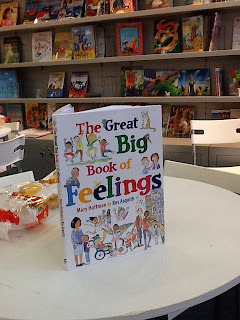
Next time I will try to post a link to the video and tell you the Faroese story.
Published on April 05, 2013 16:01
April 3, 2013
Bologna 2013 Day One
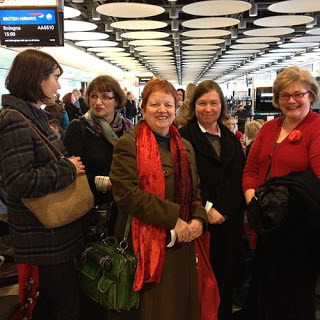 Photo by Sarah McIntyre At Heathrow 24th March 2013
Photo by Sarah McIntyre At Heathrow 24th March 2013It starts Day One minus one really, as large numbers of publishers, agents and a small sprinkling of writers and illustrators gather at the airport on Sunday. In this picture you see Liz Cross from OUP, Christine Baker from Gallimard, myself, Jane Churchill, who organises the Cheltenham Book Festival and scouts for Gallimard, and fellow author and Fair Companion Lucy Coats. Whacky artist (of which more below) Sarah McIntyre took the shot.
We also saw writer Philip Reeve, illustraor Axel Scheffler, agents Catherine Clarke, Claire Wilson and Sophie Hicks and publishers Fiona Kennedy, Helen Boyle and Ingrid Selberg. On the plane I sat next to agents Sarah Molloy and Jennifer Custer from A M Heath and had plenty of time to chat as we waited for an hour for an unaccompanied bag to be taken off the plane. Surely no-one in the children's book world would have gone to the bar at 3pm and become too tired and emotional to board the plane for Bologna?
So we missed our first party (Random House) but had a much-needed glass of prosecco with Lucy's agent Sophie Hicks and then dinner. We were all ready to hit the Fair bright and early for the first real day.

We both visited the Press Office first, bypassing the huge queues, as I was covering the Fair for BookBrunch and Armadillo and Lucy for Publishing Talk. And my first appointment was very easy - coffee with my Finnish publisher from Tammi in the Agents' Centre bar.
I am always amazed by the output and fame of writers in other countries that we simply don't know about here.Salla Simukka has written ten books already and is still only thirty; Elna Rouhiainen is only 24! If only we were less resistant to translated European literature.
Then my proper meeting with Sarah Molloy and Jennifer Custer and an introduction to a new genre for me - the "wilderness thriller." S. R. Johannes had developed her book Untraceable through the Alliance of Independent Authors, a collective of self-publishing authors and advisers that Jennifer works with a lot. Untraceable is already an Amazon bestseller and Johannes is not bothered about a conventional publishing deal.
Dodging two ?men in bright green velour onesies (this sort of thing happens all the time at Bologna) I met with Jane Walker from Barrington Stoke. They've had a great year, which saw their fifteenth anniversary, with profits up 20%, reflecting the wider scene in children's books, which has been by far the healthiest part of the publishing industry. Barrington Stoke prides itself on getting top names to write for them and have new titles from Meg Rosoff, Darren Shan, Anne Fine, Gillian Cross and Eoin Coifer.
They are also getting into picture books, with titles by Michael Morpurgo, Mike Rosen and Charlie Higson. And they are not the only ones. I met with Charlotte Williams who was covering the Fair for The Bookseller and we agreed that though day one was early to judge, the revival of picture books was a marked feature. Faber were starting a picture book list - four titles at year - and Templar have started the Big Picture Press.
I'll have more to say about picture books in my next couple of posts.
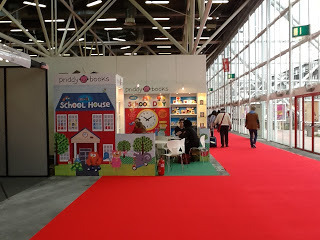
Published on April 03, 2013 02:52
March 22, 2013
Wild About Britain
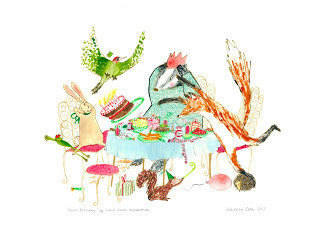 Rebecca Cobb's illustration for Hare's BirthdayDo you remember the RSPCA's Wild About Britain competition that I wrote about here a few weeks ago?
Rebecca Cobb's illustration for Hare's BirthdayDo you remember the RSPCA's Wild About Britain competition that I wrote about here a few weeks ago?The three winners were ‘The Chase’ by Ayasha Kawakita, 14, from Hailsham in East Sussex in the 12 to 16 category and ‘A New Neighbour’ by Charlotte Pearce, 11, from St Ives in Cambridgeshire was the winner of the 11 and under group.
‘Hare’s Birthday’ by Louis Baxter Wedderburn, 11, from Wolverhampton won the People’s Choice category, voted for online by the public
These children had the thrill of having their stories illustrated by professional artists:
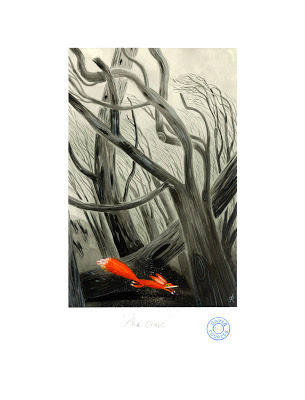 David Roberts' Illustration for The Chase
David Roberts' Illustration for The Chase Paul Howard's illustration for A New Neighbour
Paul Howard's illustration for A New Neighbour<!-- /* Font Definitions */ @font-face {font-family:"Times New Roman"; panose-1:0 2 2 6 3 5 4 5 2 3; mso-font-charset:0; mso-generic-font-family:auto; mso-font-pitch:variable; mso-font-signature:50331648 0 0 0 1 0;} @font-face {font-family:Arial; panose-1:0 2 11 6 4 2 2 2 2 2; mso-font-charset:0; mso-generic-font-family:auto; mso-font-pitch:variable; mso-font-signature:50331648 0 0 0 1 0;} @font-face {font-family:"Courier New"; panose-1:0 2 7 3 9 2 2 5 2 4; mso-font-charset:0; mso-generic-font-family:auto; mso-font-pitch:variable; mso-font-signature:50331648 0 0 0 1 0;} @font-face {font-family:Wingdings; panose-1:0 5 2 1 2 1 8 4 8 7; mso-font-charset:2; mso-generic-font-family:auto; mso-font-pitch:variable; mso-font-signature:0 16 0 0 -2147483648 0;} @font-face {font-family:Tahoma; panose-1:0 2 11 6 4 3 5 4 4 2; mso-font-charset:0; mso-generic-font-family:auto; mso-font-pitch:variable; mso-font-signature:50331648 0 0 0 1 0;} @font-face {font-family:"Arial Black"; panose-1:0 2 11 10 4 2 1 2 2 2; mso-font-charset:0; mso-generic-font-family:auto; mso-font-pitch:variable; mso-font-signature:50331648 0 0 0 1 0;} @font-face {font-family:"Wingdings 2"; panose-1:0 5 2 1 2 1 5 7 7 7; mso-font-charset:2; mso-generic-font-family:auto; mso-font-pitch:variable; mso-font-signature:0 16 0 0 -2147483648 0;} /* Style Definitions */ p.MsoNormal, li.MsoNormal, div.MsoNormal {mso-style-parent:""; margin:0cm; margin-bottom:.0001pt; mso-pagination:widow-orphan; font-size:12.0pt; font-family:"Times New Roman"; mso-ansi-language:EN-GB;} h1 {mso-style-next:Normal; margin:0cm; margin-bottom:.0001pt; mso-pagination:widow-orphan; page-break-after:avoid; mso-outline-level:1; font-size:47.0pt; font-family:"Arial Black"; mso-font-kerning:0pt; mso-ansi-language:EN-GB; font-weight:normal;} h2 {mso-style-next:Normal; margin:0cm; margin-bottom:.0001pt; mso-pagination:widow-orphan; page-break-after:avoid; mso-outline-level:2; font-size:26.0pt; font-family:"Arial Black"; mso-ansi-language:EN-GB; font-weight:normal;} p.MsoFootnoteText, li.MsoFootnoteText, div.MsoFootnoteText {margin:0cm; margin-bottom:.0001pt; mso-pagination:widow-orphan; font-size:10.0pt; font-family:"Times New Roman"; mso-ansi-language:EN-GB;} p.MsoHeader, li.MsoHeader, div.MsoHeader {margin:0cm; margin-bottom:.0001pt; mso-pagination:widow-orphan; tab-stops:center 216.0pt right 432.0pt; font-size:12.0pt; font-family:"Times New Roman"; mso-ansi-language:EN-GB;} p.MsoFooter, li.MsoFooter, div.MsoFooter {margin:0cm; margin-bottom:.0001pt; mso-pagination:widow-orphan; tab-stops:center 216.0pt right 432.0pt; font-size:12.0pt; font-family:"Times New Roman"; mso-ansi-language:EN-GB;} a:link, span.MsoHyperlink {mso-style-parent:""; color:blue; text-decoration:underline; text-underline:single;} a:visited, span.MsoHyperlinkFollowed {mso-style-parent:""; color:purple; text-decoration:underline; text-underline:single;} em {mso-style-parent:"";} p.Mainheading, li.Mainheading, div.Mainheading {mso-style-name:"Main heading"; margin-top:0cm; margin-right:0cm; margin-bottom:5.0pt; margin-left:0cm; mso-pagination:widow-orphan; font-size:22.0pt; font-family:"Arial Black"; mso-ansi-language:EN-GB;} p.PRmaintext, li.PRmaintext, div.PRmaintext {mso-style-name:"PR main text"; margin:0cm; margin-bottom:.0001pt; line-height:14.0pt; mso-line-height-rule:exactly; mso-pagination:widow-orphan; font-size:10.0pt; font-family:Arial; mso-ansi-language:EN-GB;} p.Subsubheading, li.Subsubheading, div.Subsubheading {mso-style-name:"Sub sub heading"; mso-style-parent:"Footnote Text"; margin-top:0cm; margin-right:0cm; margin-bottom:4.0pt; margin-left:0cm; mso-pagination:widow-orphan; font-size:10.0pt; font-family:"Arial Black"; mso-ansi-language:EN-GB;} p.Heading, li.Heading, div.Heading {mso-style-name:Heading; mso-style-parent:"Footnote Text"; margin-top:0cm; margin-right:0cm; margin-bottom:4.0pt; margin-left:0cm; mso-pagination:widow-orphan; font-size:14.0pt; font-family:"Arial Black"; mso-ansi-language:EN-GB;} p.Bullets, li.Bullets, div.Bullets {mso-style-name:Bullets; margin-top:6.0pt; margin-right:14.2pt; margin-bottom:0cm; margin-left:17.85pt; margin-bottom:.0001pt; text-indent:-17.85pt; line-height:13.0pt; mso-line-height-rule:exactly; mso-pagination:widow-orphan; mso-list:l0 level1 lfo10; tab-stops:list 18.0pt center 225.6pt; font-size:10.0pt; font-family:Arial; mso-ansi-language:EN-GB;} p.Squarebullets, li.Squarebullets, div.Squarebullets {mso-style-name:"Square bullets"; mso-style-parent:Bullets; margin-top:12.0pt; margin-right:14.2pt; margin-bottom:0cm; margin-left:18.0pt; margin-bottom:.0001pt; text-indent:-18.0pt; line-height:13.0pt; mso-line-height-rule:exactly; mso-pagination:widow-orphan; mso-list:l1 level1 lfo7; tab-stops:list 18.0pt center 225.6pt; font-size:10.0pt; font-family:Arial; mso-ansi-language:EN-GB;} p.Numbers, li.Numbers, div.Numbers {mso-style-name:Numbers; margin-top:6.0pt; margin-right:0cm; margin-bottom:0cm; margin-left:18.0pt; margin-bottom:.0001pt; text-indent:-18.0pt; line-height:11.0pt; mso-line-height-rule:exactly; mso-pagination:widow-orphan; mso-list:l3 level1 lfo9; tab-stops:list 18.0pt; font-size:10.0pt; font-family:Arial; color:black; mso-ansi-language:EN-GB;} p.PRintroduction, li.PRintroduction, div.PRintroduction {mso-style-name:"PR introduction"; margin:0cm; margin-bottom:.0001pt; line-height:13.5pt; mso-line-height-rule:exactly; mso-pagination:widow-orphan; font-size:8.5pt; font-family:"Arial Black"; color:navy; mso-ansi-language:EN-GB;} p.Giantheading, li.Giantheading, div.Giantheading {mso-style-name:"Giant heading"; mso-style-parent:"Main heading"; margin-top:0cm; margin-right:0cm; margin-bottom:5.0pt; margin-left:0cm; mso-pagination:widow-orphan; font-size:36.0pt; font-family:"Arial Black"; mso-ansi-language:EN-GB;} span.HeaderChar {mso-style-name:"Header Char"; mso-style-parent:""; font-size:12.0pt;} p.BalloonText, li.BalloonText, div.BalloonText {mso-style-name:"Balloon Text"; margin:0cm; margin-bottom:.0001pt; mso-pagination:widow-orphan; font-size:8.0pt; font-family:Tahoma; mso-ansi-language:EN-GB;} span.BalloonTextChar {mso-style-name:"Balloon Text Char"; mso-style-parent:""; font-size:8.0pt;} p.PRmainheading, li.PRmainheading, div.PRmainheading {mso-style-name:"PR main heading"; mso-style-parent:"Heading 2"; margin:0cm; margin-bottom:.0001pt; line-height:26.0pt; mso-line-height-rule:exactly; mso-pagination:widow-orphan; page-break-after:avoid; mso-outline-level:2; font-size:21.0pt; font-family:"Arial Black"; color:navy; mso-ansi-language:EN-GB;} p.PRsubheading, li.PRsubheading, div.PRsubheading {mso-style-name:"PR subheading"; mso-style-parent:"Heading 2"; margin:0cm; margin-bottom:.0001pt; mso-pagination:widow-orphan; page-break-after:avoid; mso-outline-level:2; font-size:13.0pt; font-family:"Arial Black"; color:navy; mso-ansi-language:EN-GB;} p.PRdate, li.PRdate, div.PRdate {mso-style-name:"PR date"; mso-style-parent:"PR main text"; margin-top:0cm; margin-right:0cm; margin-bottom:6.0pt; margin-left:0cm; line-height:13.5pt; mso-line-height-rule:exactly; mso-pagination:widow-orphan; font-size:8.0pt; font-family:Arial; color:navy; mso-ansi-language:EN-GB;} p.PRbullets, li.PRbullets, div.PRbullets {mso-style-name:"PR bullets"; mso-style-parent:Bullets; margin-top:6.0pt; margin-right:14.2pt; margin-bottom:0cm; margin-left:17.85pt; margin-bottom:.0001pt; text-indent:-17.85pt; line-height:13.0pt; mso-line-height-rule:exactly; mso-pagination:widow-orphan; mso-list:l2 level1 lfo11; tab-stops:center 17.85pt; font-size:10.0pt; font-family:Arial; mso-ansi-language:EN-GB;} p.PRsmallheading, li.PRsmallheading, div.PRsmallheading {mso-style-name:"PR small heading"; mso-style-parent:"PR introduction"; margin-top:0cm; margin-right:0cm; margin-bottom:3.0pt; margin-left:0cm; mso-pagination:widow-orphan; font-size:8.5pt; font-family:"Arial Black"; color:navy; mso-ansi-language:EN-GB;} span.apple-converted-space {mso-style-name:apple-converted-space;} @page Section1 {size:612.0pt 792.0pt; margin:72.0pt 90.0pt 72.0pt 90.0pt; mso-header-margin:36.0pt; mso-footer-margin:36.0pt; mso-paper-source:0;} div.Section1 {page:Section1;} /* List Definitions */ @list l0 {mso-list-id:220289516; mso-list-type:simple; mso-list-template-ids:-1299277060;} @list l0:level1 {mso-level-number-format:bullet; mso-level-style-link:Bullets; mso-level-text:; mso-level-tab-stop:18.0pt; mso-level-number-position:left; margin-left:17.85pt; text-indent:-17.85pt; font-family:"Wingdings 2";} @list l1 {mso-list-id:291520296; mso-list-type:simple; mso-list-template-ids:-919155260;} @list l1:level1 {mso-level-number-format:bullet; mso-level-style-link:"Square bullets"; mso-level-text:; mso-level-tab-stop:18.0pt; mso-level-number-position:left; margin-left:18.0pt; text-indent:-18.0pt; font-size:12.0pt; font-family:Wingdings;} @list l2 {mso-list-id:873621008; mso-list-type:hybrid; mso-list-template-ids:1962463074 -2026613990 198665 329737 67593 198665 329737 67593 198665 329737;} @list l2:level1 {mso-level-number-format:bullet; mso-level-style-link:"PR bullets"; mso-level-text:; mso-level-tab-stop:none; mso-level-number-position:left; text-indent:-18.0pt; font-family:"Wingdings 2"; color:navy;} @list l3 {mso-list-id:2015184501; mso-list-type:simple; mso-list-template-ids:1317073590;} @list l3:level1 {mso-level-style-link:Numbers; mso-level-tab-stop:18.0pt; mso-level-number-position:left; margin-left:18.0pt; text-indent:-18.0pt; font-size:9.5pt; font-family:Arial; font-weight:normal; font-style:normal;} @list l4 {mso-list-id:2110810665; mso-list-type:simple; mso-list-template-ids:-1480683430;} @list l4:level1 {mso-level-tab-stop:18.0pt; mso-level-number-position:left; margin-left:18.0pt; text-indent:-18.0pt; font-size:9.5pt; font-family:Arial; font-weight:normal; font-style:normal;} ol {margin-bottom:0cm;} ul {margin-bottom:0cm;} </style></span></span></span></div><br />To read the full stories along with information about the silver and bronze award winners in each category, visit <a href="http://www.wildaboutbritain.org.uk/&q... /> <br /><div class="PRmaintext"><span style="font-size: x-small;"><span style="font-family: inherit;"> </span></span></div>
Published on March 22, 2013 08:50
Mary Hoffman's Blog
- Mary Hoffman's profile
- 591 followers
Mary Hoffman isn't a Goodreads Author
(yet),
but they
do have a blog,
so here are some recent posts imported from
their feed.



